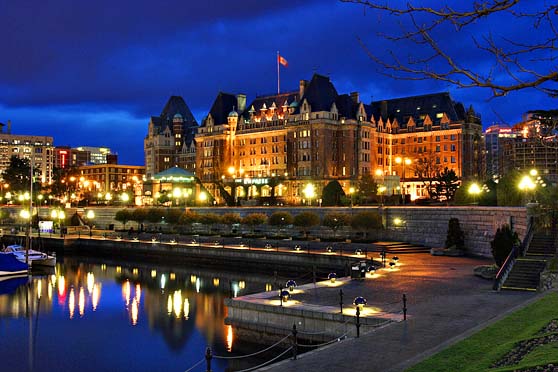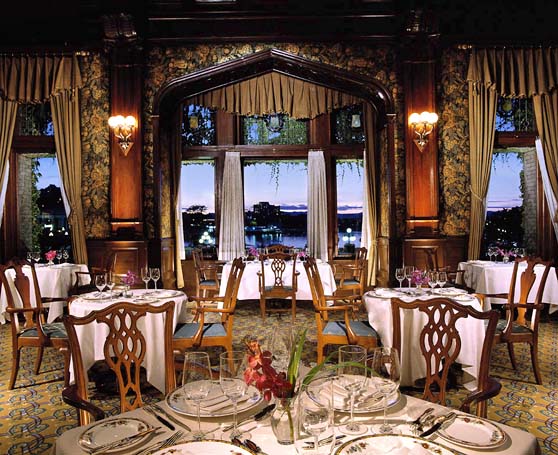

The ex-Canadian Pacific Railway Empress hotel on Vancouver Island in Victoria,
British Columbia. |
20 May 2011
Revisiting Canada's Grand Railway Hotels
Victoria Vancouver Island British Columbia - Sunk in a plush wingback chair, at a lacquered table clustered with heavy silver teapots
and petite finger sandwiches, in a salon swimming in chintz, creams, and pastels, I am being initiated into the rite of afternoon tea. It's a shame I didn't
know about this sooner.
Between bites of lemon curd tarts and sips of Earl Grey, I soak up the good life.
A classical pianist plays softly in the corner. Servers in crisp vests carry trays of shortbreads and scones. There are actual sugar cubes on the table. In
fact, pretty much every detail in the lobby of the Fairmont Empress Hotel, the 477-room Edwardian masterpiece rising castle like above Victoria harbor in
western Canada, evokes the genteel grandeur of an earlier time, except maybe the couple at the next table snapping shots of their scones on iPhones.
Built in 1908 for an unprecedented sum of $465,000, the Empress was a final jewel in a crown of uncommonly palatial hotels strung across the wilds of western
Canada. To attract passengers to the hinterlands of the continent, the great Canadian Pacific Railway erected more than a dozen so-called "castles of the
North" around the turn of the last century, colossal chateaus replete with soaring towers and grand ballrooms in what were the remotest of outposts.
Europe's leisure class and America's nouveau riche streamed in for the Canadian Grand Tour, a months-long luxury safari by train.
For many visitors, that epic transcontinental journey began in Victoria, the prim provincial capital christened after the British monarch and located just off
the west coast of Canada on Vancouver Island. Steamers from Hong Kong and Shanghai, San Francisco and Seattle, would sail into port, passengers jostling on
deck for a glimpse of the grand Empress Hotel, seven stories of warm red brick, ornate friezes, and copper-topped turrets rising above the bay.
Polishing off the last of my rose-petal shortbreads, I watch through the tea lobby's ivy-trimmed windows as a modern-day ferry from Washington sidles into the
harbor, unloading a cargo of day-trippers in rumpled travel gear.
Outside the hotel, the prospect today, apart from a few newer buildings, is surprisingly similar to the one that greeted visitors more than a century ago. I
amble along Victoria's Inner Harbour, busy on this brisk spring afternoon with sleek sailboats and a few float planes arriving from nearby Vancouver, 40 miles
away on the Canadian mainland. Horse-drawn carriages with drivers in fancy dress trot tourists around the bay, while in the distance the tarnished copper dome
of the city's baroque parliament building presides with dignified aloofness.
Empress Hotel tour
"She was named after Queen Victoria, who was also the empress of India, and you'll see a lot of this colonial influence as we wander through the
hotel," says Mandy Kray, an unabashed Anglophile who grew up in the shadow of the Empress and now leads historical tours of the hotel for the bargain
price of $10. She's dressed in period costume: broad-brimmed hat trimmed with peacock feathers that bounce when she nods, waistcoat, and matching hobble
skirt of blue silk, and long black gloves pulled up to her elbows in fine belle epoque style. Moving through the lobby, she draws stares from business
travelers checking in.
Our little tour group peeks into libraries with vaulted ceilings and jade fireplaces, traipses through grand ballrooms with ornate stained-glass domes, and
ogles the royal china made for the visit by Queen Elizabeth in 1939. Meanwhile, Kray expounds on the Empress' glittering youth of gala balls and hoop skirts,
visits from Hollywood royalty, and real royalty through the years, and, not least, the Empress widows.
It seems back in the 1930s, at the height of the Depression, Victoria's wealthy widows, husbands long gone and fortunes dwindling, turned to the hotel for
sanctuary.
"They ended up staying for years, in some cases decades," Kray says as we cross the Empress' manicured lawns under a light drizzle, "living up
on the sixth floor for $1 a day." I crane my head upward to the attic windows, imagining the dowagers whiling away their dotage in the lap of luxury.
Later that evening, after a nightcap or two at the hotel bar, a conspiratorial den of dark wood with a real tiger skin hung above the fireplace, I'm snug in my
balcony room overlooking the harbor, watching as storm winds whip the water into whitecaps. In a gesture that puts pillow mints to shame, staff have left at my
bedside a spread of truffles and white and dark chocolates, all tucked into a delicate chocolate teacup.
My mind drifts back to the old Empress widows, pleasantly sequestered for all those years in this world of afternoon teas, florid salons, and reading rooms,
interminable cocktail hours, and forgotten Victorian niceties. As grand resorts go, the Empress is staid, stodgy, and antiquated, gloriously so, a time warp to
an era when aristocratic excess and refined indulgence reigned.
If only the rooms were still $1 a day.
Remy Scalza.

Inside the ex-Canadian Pacific Railway Empress hotel. |

|